Hiking in Gran Canaria: we uncover hidden treasures in a wild and welcoming land

Arriving at Roque Nublo, a 260-foot high monolith that sits atop a broad expanse of volcanic rock in the center of Gran Canaria, feels a bit like landing on the moon. From this viewpoint, panoramic views of the Tejeda Caldera reveal a wealth of geographical treasures: to the northeast, the lush, pine-covered mountains of Pico De Las Nieves. To the south, a glimpse of the famous Maspalomas Sand Dunes, a 400-hectare desert oasis. To the west, on a clear day like today, the distinctive peak of Teide on Tenerife Island – the highest point in all of Spain.
The iconic landmark that towers over me now is named “cloudy rock” because it is often blanketed in clouds that roll like a slow river over the nearby mountains. Today, however, there's an unblotted sky and I’m glad I dressed lightly in hiking shorts and breathable trail running shoes for the short but steep climb from El Garañon, an outdoors camp that sits at 5,577 feet above sea level and serves as a base for outdoor adventurers.
Roque Nublo is the tallest of several rock towers along the rim that remained standing when a volcano that formed the island collapsed in on itself some 15 millions years ago. The large basin stretches from this central point down to the Atlantic via the westernmost tip of the island. Gazing down there now, I can see the point where I stood less than 24 hours ago after hiking a desert trail in Parque Natural de Tamadaba where the arid landscape suddenly drops off into the glittering ocean via dramatic cliffs where foamy waves crash below.
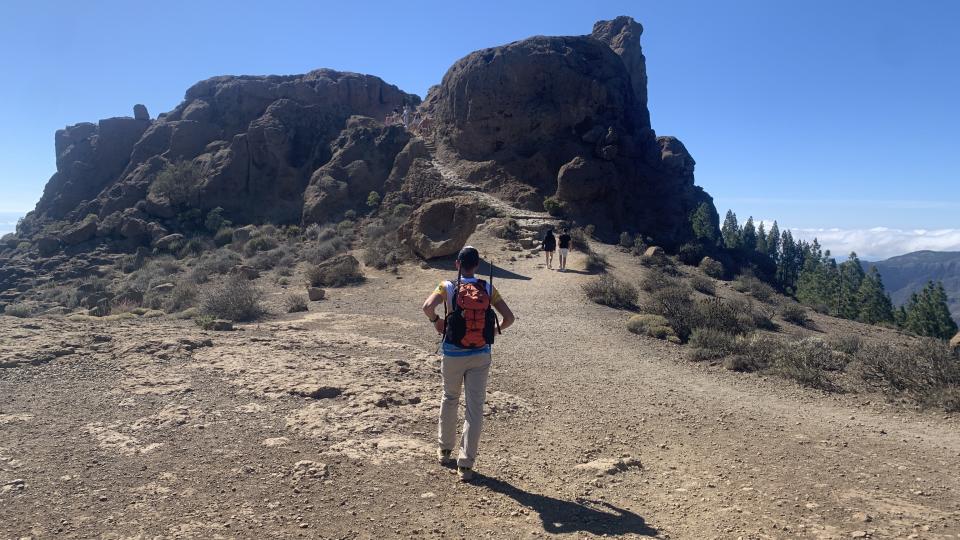
I’m quickly learning that surprises and fascinating contrasts lie round every corner on this island. Yesterday, I stood at a cliff edge where the cool tradewinds were strong enough whip my hat off. I took just one step backwards and found myself enveloped in a warm stillness disturbed only by the lazy buzzing of a fly and occasional chirp of a native canary bird.
The day prior, when I arrived to the agricultural town of La Aldea, the surrounding mountainsides appeared barren and parched. Once I started out on the hiking trail, however, my knowledgeable guide Guillermo from Gran Canaria Natural and Active showed me signs of life at every turn. The seemingly dead vegetation turned out to be balsam spurge dotted upon closer inspection with tiny yellow flowers and the dark coastal rocks turned out to be blanketed with an unassuming lichen that was historically mixed with ammonia to make purple dye used in clothing.
I’ll admit that prior to this trip, I was ignorant about Gran Canaria. I knew that reliably warm winter temperatures mean British tourists flock here from December to March, fed up of the long, dark winter back home and I assumed that sunshine, beaches and cheap booze were the main draw. Instead, I discover an island that is both welcoming and wild, mysterious and accessible, and very much ready for adventure whether you want to pull on a wetsuit or hiking boots, go bird watching or wine tasting.
Off the coast, there’s diving and surfing (two windsurfing world champions hail from here) and inland you’ll find via ferrata routes and a plethora of hiking trails that draw people from all over the world during the island’s annual October walking festival.
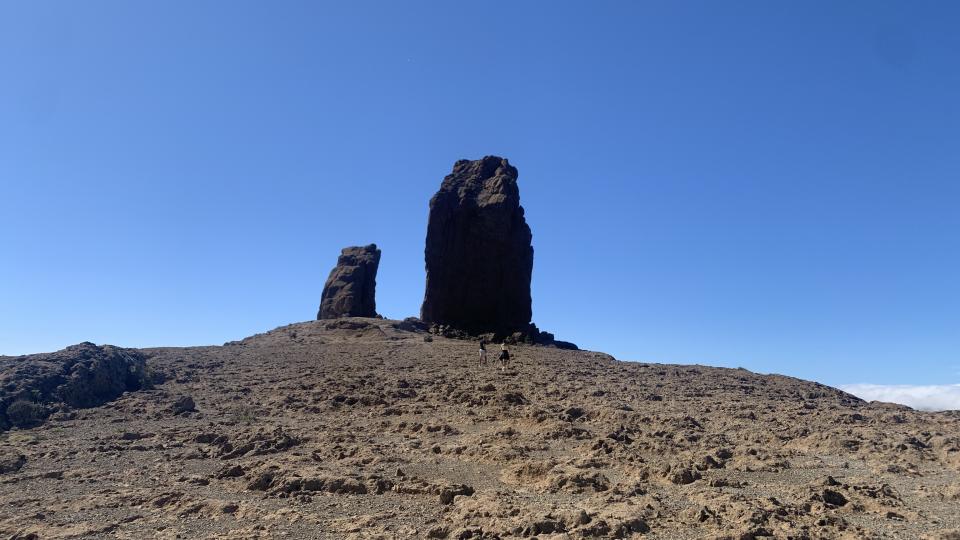
People have lived on Gran Canaria for 2,000 years when the first settlers arrived from northern Africa. Their descendants lived here harmoniously until the 1400s, when they fought off two invasions by the Normans and two more by the Portuguese before finally succumbing to the Castillans in 1496 after years of bloody battle.
The celebrated Spanish writer Miguel de Unamuno was exiled to the Canary Islands in 1930 and had the last laugh, falling in love with the landscape and urging those traveling across the ocean not to bypass the islands, writing: “Don’t miss out on stepping onto dry land and if you have time, make your way inland. You won’t be wasting your time, I assure you”.
Hiking in Gran Canaria
Getting there: Regular flights into the international airport then a 20 minute drive to Las Palomas, 45 minutes to Agaete and an hour to Tejeda. Ferries depart from Tenerife every two hours.
Accommodations: Hotel La Aldea Suites provides delightful accommodations in the agricultural town of La Aldea; Hotel Rural Las Longueras is a rustic retreat in Agaete; Hotel Fonda de la Tea is an idyllic spot in a protected mountain village.
Where to eat: Las Nasas in Agaete for freshly caught fish in a breezy seafront setting and Cueva de la Tea Restaurant in Tejeda for nourishing lentejas Lanzarote. What to do: Gran Canaria Natural & Active organizes many activities and itineraries to get to know the natural side of Gran Canaria with knowledgable guides.
Rather than the hot summers and mild winters I’m familiar with on mainland Spain’s Mediterranean coast, the island enjoys pleasant temperatures hovering around 70 degrees year-round, providing a welcome break from winter’s cold but largely remaining extremely hospitable to those of us who like to hike and bike.
La Aldea is a lively agricultural town that probably isn’t yet on the typical tourist’s radar – I have one of its utopian black sand beaches to myself for hours on a sunny Saturday afternoon. However it seems unlikely things will stay that way for long. The town is surrounded by the three oldest mountain ranges on the island which are already mapped out for explorers with well-cut trails and viewpoints equipped with visual guides for stargazing, something these islands are world-famous for.
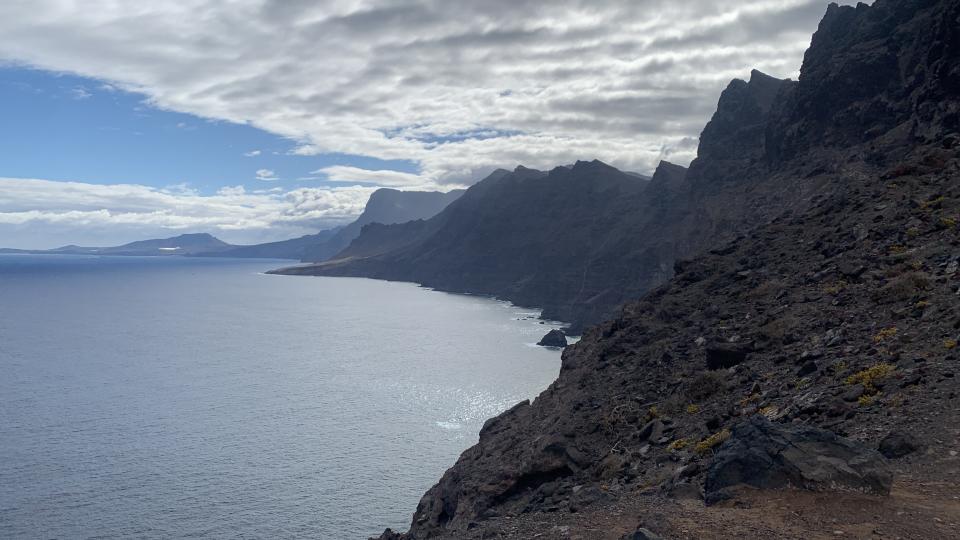
After a night at the town’s only hotel, Hotel La Aldea Suites, where I encounter rustic charm and a sparkling pool with rugged mountain views to cool off by after hiking, we drive north along the exhilarating GC-200, a rugged coastal highway (a fast, replacement road is under construction, with plans to turn this one into a stunning walking and cycling route). By lunchtime, we’re wandering along the seafront of Agaete, a picture-perfect seaside town where all but three of the low-lying buildings are painted white with cobalt trim in pleasing contrast to the black volcanic rock surroundings. From here, looking south, is the best view of the west island’s stunning rugged coastline, known affectionately as “the dragon’s tail.”
It’s Sunday, and locals sun themselves on pebble beaches in preparation for a traditional family lunch while the ferry waits to whisk people across to Tenerife, a short 90-minute journey away. The port provides a sheltered bay perfect for recreational use, and the infrastructure put in place for the fishing boats that used to bring their hauls in here has been adapted so that open water swimmers and kayakers can easily access the crystal clear waters.
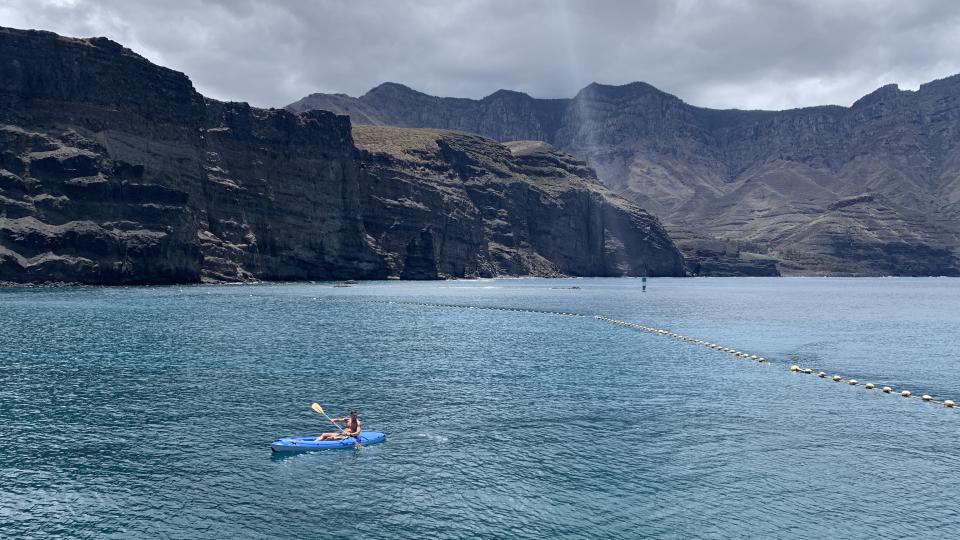
After a feast of smoky green peppers and freshly-caught white Sama fish washed down with a dry Canarian white wine – the grapevines in the Canary Islands were spared the decimation of the 1858 phylloxera plague and the islands boast Europe’s only heirloom grapes – we drive a couple of miles up valley where Hotel Rural Las Longueras delivers another bewitching surprise.
One of only four hotels in town, this handsome 19th century house is painted red and sits in several acres of manicured grounds at the edge of one of Europe’s few coffee plantations. Settling into the sun room to enjoy the last of the rays over the sea, it’s the type of place I can imagine coming to convalesce or writing a novel.

In the morning, I breakfast with views of the Tamadaba mountain range and I’m a little bereft to be leaving my tranquil retreat so soon, but we begin another scenic drive around the northwest corner of the island before turning inland to climb a winding road. On route, the arid terrain falls away and is replaced by green pine forest thanks to the constant moisture that gets trapped between the trade winds and the mountains, just one of many microclimates that grant the island its nickname of “the miniature continent.”
My final destination is the idyllic mountain village of Tejeda. At 3,400 feet above sea level and flanked by the two tallest mountains in Gran Canaria, this enchanting town manages to live up to the billboard proclaiming it as “one of the most beautiful towns in Spain.”
Hotel Fonda de la Tea is a rustic retreat where my room opens out onto a terrace with stunning views up towards Roque Nublo and I rest here before driving up to the alpine camp to begin my hike to the rock. I’m met by Jaime from Vivac Aventura, a company that specializes in guided outdoor adventures, and he leads me on the three-kilometer rocky trail through the trees that suddenly opens up onto a wide, flat summit. Here, the absence of any breeze and late afternoon sun have me reaching for my water bottle, but as soon as we begin our descent, the temperature seems to drop 10 degrees thanks to what Jaime calls the “magic of the pine trees” and I’m comfortable again.

A winding six-kilometer descent back to town guides us down the trail used by the world’s most elite trail runners in the Transgrancanaria race. We make it in time for one more dreamy sunset that makes the otherworldly landscape seem all the more magical before the view slips into the velvety darkness and twinkling constellations emerge overhead. I can’t help thinking there’s so much more waiting to be discovered here.
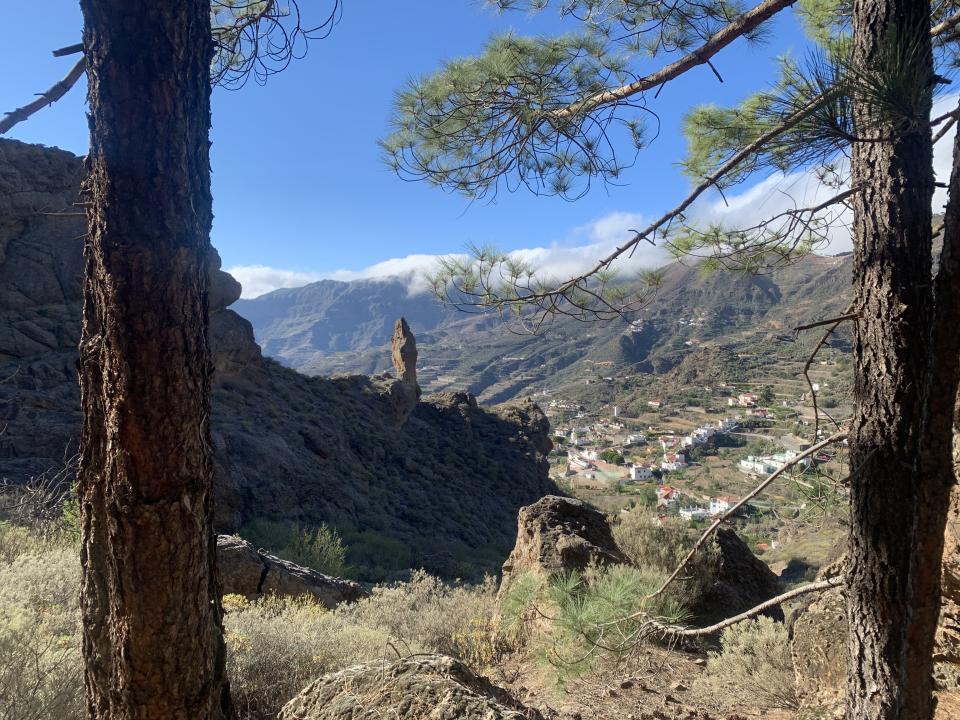
What to pack for hiking in Gran Canaria
Gran Canaria maintains a very consistent temperature throughout the year, but within this small island are many microclimates and it’s worth packing layers for ocean breezes and cold nights in the mountains. I packed very light for my hiking adventure to avoid checking a bag, and relied on natural materials so I could wear the same clothes multiple times.

